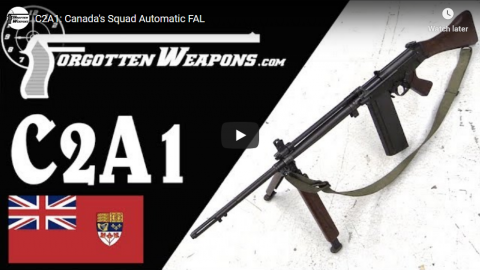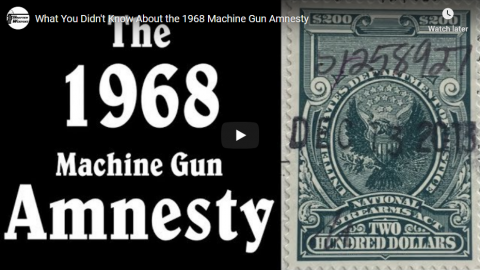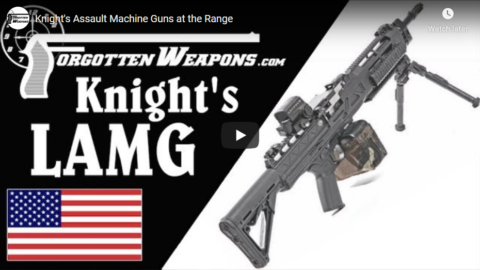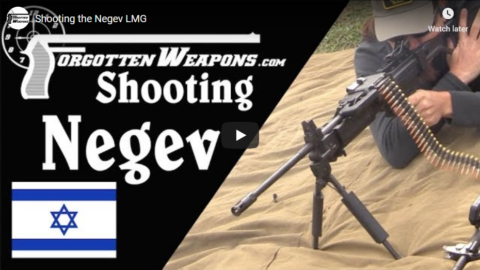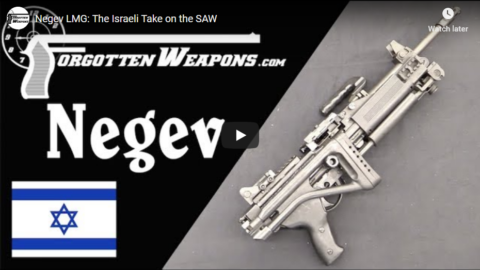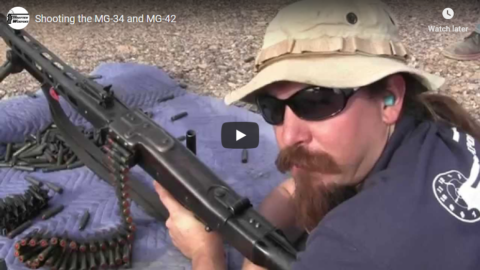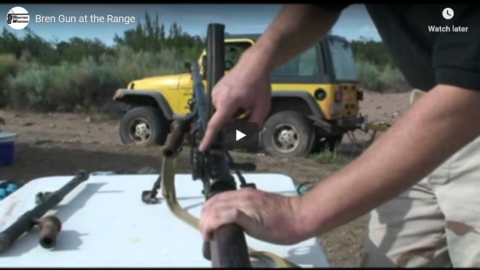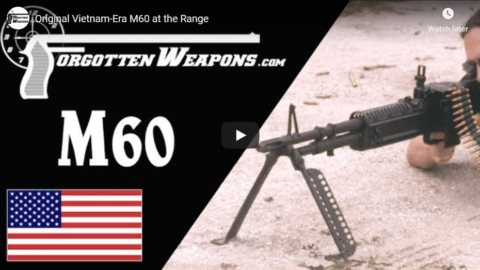Forgotten Weapons
Published on 6 Sep 2019http://www.patreon.com/ForgottenWeapons
Cool Forgotten Weapons merch! http://shop.bbtv.com/collections/forg…
Canada was the first country to formally adopt the FN FAL as its standard service rifle, and in 1958 it added the C2 light machine gun version of the FAL to its arsenal. The C2, later updated to C2A1, was a heavy-barreled version of the regular FAL rifle. It shared all the same basic action components, but with a dual-use bipod/handguard, a rear sight calibrated out to 1000 meters, and 30-round magazines as standard. The gun was mechanically fine, but not a great light support weapon, as its rifle lineage sacrificed handling and sustained fire capability. Only about 2700 were produced, and it was ultimately replaced by the C9 (FN Minimi) in the 1980s.
Many thanks to Movie Armaments Group in Toronto for the opportunity to showcase their AR-10 rifles for you! Check them out on Instagram to see many of the guns in their extensive collection:
https://instagram.com/moviearmamentsg…
http://www.moviearms.comContact:
Forgotten Weapons
PO Box 87647
Tucson, AZ 85754
September 7, 2019
C2A1: Canada’s Squad Automatic FAL
September 6, 2019
Browning M2 .50cal “Ma Deuce” | HEAVY MACHINE GUN
Matsimus
Published on 22 Jul 2019The Browning heavy machine gun was designed towards the end of World War I. Development of a large-caliber machine gun in the USA was initiated at the direct request of General Pershing, the commander of US expeditionary corps in Europe. He requested a large-caliber machine gun, capable of destroying military aircraft and ground targets such as armored cars and tanks. The task of developing such a gun was passed to John Browning. The task of developing ammunition for this new weapon was passed to Winchester Arms company.
This machine gun is similar to John Browning’s earlier M1919 machine gun, that was chambered for a standard rifle cartridge. In around 1917 Browning started to redesign his weapon for a larger caliber. His new machine gun was chambered for much larger and much more powerful 12.7×99 mm (.50 caliber) cartridge, that was developed alongside this weapon by Winchester. That’s why sometimes this weapon is simply referred as Browning .50 caliber machine gun. After the John Browning’s death in 1926, the design of this weapon was finalized by other designers.
This machine gun entered service with the US armed forces in 1933 and was manufactured by Colt. Design of this weapon proved to be extremely successful. Since the 1930s it has been used extensively to the present day. This remarkable weapon has seen service during countless wars all over the world. Only during WWII nearly 2 million of these HMGs were produced. It has been in production longer than any other machine gun and its production still continues. Furthermore the M2 machine gun has been in use longer than any other small arm in the US armed forces inventory, except the M1911 pistol, that was also designed by John Browning. The M2 machine gun is currently manufactured by General Dynamics and US Ordnance companies. Since the 1930s this weapon is license-produced by FN Herstal of Belgium. Currently the M2 is used by about 100 countries all over the world. It is the primary heavy machine gun of NATO countries.
The M2 is typically used as a vehicle weapon or helicopter armament. It can be also used from a tripod. This heavy machine gun is highly effective against infantry, unarmored or lightly armored vehicles, boats, light fortifications and helicopters. It is closer in power to a small cannon.
This weapon is typically used with standard ball, tracer, armor-piercing, armor-piercing incendiary, or armor-piercing incendiary tracer rounds. There is also an M962 SLAP-T (Saboted Light Armor Penetrator) round, fitted with a tungsten penetrator.
The M2 is fed from disintegrating belt. Spent cartridge cases are extracted down. It can be adapted to feed from the left or right side of the weapon by reinstalling some parts. This conversion takes two minutes. The charging handle can be also changed from right to left hand side.
The M2 has slow and rapid firing modes. It can fire full-auto, as well as single shots. This weapon fires from a closed bolt.
When used as a crew served weapon, the M2 is mounted on an M3 tripod. This tripod weights 20 kg. So the complete weight of the machine gun on tripod is 58 kg. When fired from the tripod this HMG has an effective range of 1 830 m. Maximum effective range is 2 000 m.
The M2 comes with standard iron sights. However various types of telescopic and night sights can be installed using appropriate mountings.
Hope you enjoy!!
Want to support my channel? Check out my Patreon Donation page! https://www.patreon.com/user?u=3081754
Check out my Merch: https://teespring.com/stores/matsimus…
Wanna send me something? My PO Box: Matthew James 210A – 12A Street N Suite
#135 Lethbridge Alberta Canada T1H2J
Twitch: https://www.twitch.tv/matsimus_9033
DISCORD: https://discord.gg/B7cbXgy
Twitter: https://twitter.com/MatsimusGaming
(DISCLAIMER: This video is for informative and entertainment purposes only. The views and opinion come from personal experience and not that of others or other organizations. This content and information is there to provide information from public accessible sources.)
September 2, 2019
What You Didn’t Know About the 1968 Machine Gun Amnesty
Forgotten Weapons
Published on 11 Oct 2017Sold for $23,000.
When the 1968 machine gun amnesty was announced in the US, it was treated with widespread suspicion among gun collectors. Some thought it would merely a pretense to find and arrest owners of unregistered machine guns. Others though it was just the first step in a prohibition and confiscation of machine guns. Both of these groups would prove to be wrong, however and the amnesty was in fact a true amnesty.
In fact, the amnesty was even more substantial than people recognize even today. It was not just an amnesty for possession of an unregistered machine gun, but also pretty much any crime associated with the gun. For example, it would legalize guns that had been stolen from military property rooms, and guns with defaced serial numbers. In fact, it even allowed felons to register machine guns, and retain the legal right to own them to this very day.
http://www.patreon.com/ForgottenWeapons
Cool Forgotten Weapons merch! http://shop.bbtv.com/collections/forg…
If you enjoy Forgotten Weapons, check out its sister channel, InRangeTV! http://www.youtube.com/InRangeTVShow
August 1, 2019
Maxim “Prototype”: The First Practical Machine Gun
Forgotten Weapons
Published on 31 Jul 2019http://www.patreon.com/ForgottenWeapons
Cool Forgotten Weapons merch! http://shop.bbtv.com/collections/forg…
Hiram Maxim was the first person to create a truly practical and functional machine gun, based on a patent he filed in 1883. He pioneered the recoil operating system – the concept of harnessing the recoil generated by a firearm to perform the actions of reloading that firearm. His patent was based on a lever action rifle, but his intent was to create a machine gun, complete with belt feed and water cooling. After a testbed “forerunner” gun, he built this model which he called the “Prototype”. It was meant as a proof of concept, and used in many public exhibitions and demonstrations.
The Prototype used a hydraulic rate of fire control system which could be set as high as 500 rounds/minute and as low as just one round per minute. The gun did not have a trigger as we would recognize it today, but rather a single lever like a vehicle accelerator which acted as both trigger and fire rate control. Only three of these Prototypes exist today, with one belonging to the USMC, one on public display at the Royal Armouries museum in Leeds, and this one in the NFC reserve collection at Leeds.
For a fantastic exploded view of all this guns working parts, check out this work by YouTube channel vbbsmyt:
Many thanks to the Royal Armouries for allowing me to film this tremendously important artifact! The NFC collection there — perhaps the best military small arms collection in Western Europe — is available by appointment to researchers:
https://royalarmouries.org/research/n…
You can browse the various Armouries collections online here:
https://royalarmouries.org/collection/
Contact:
Forgotten Weapons
PO Box 87647
Tucson, AZ 85754
July 16, 2019
Knight’s Assault Machine Guns at the Range
Forgotten Weapons
Published on 11 May 2019Preorders now open for my book, “Chassepot to FAMAS: French Military Rifles 1866-2016”! Get your copy here:
https://www.kickstarter.com/projects/…
Knights Armament introduced their “Assault Machine Gun” a couple years ago, and I had a chance to take both versions (5.56mm and 7.62mm) out to the range recently. The gun is the spiritual descendant of the Stoner 63, but is more directly made on Eugene Stoner’s Model 86 light machine gun. It utilizes the constant recoil principle, with the bolt never actually contacting the rear of the receiver during the cycling process. This results in recoil being felt by the shooter as a continuous steady force instead of a rapid series of impacts and that makes it tremendously controllable. Not surprisingly, these guns are already being sold to military and security organizations worldwide…
http://www.patreon.com/ForgottenWeapons
Cool Forgotten Weapons merch! http://shop.bbtv.com/collections/forg…
Contact:
Forgotten Weapons
PO Box 87647
Tucson, AZ 85754
June 23, 2019
Shooting the Negev LMG
Forgotten Weapons
Published on 22 Jun 2019My first book is available for pre-order; check it out!
https://www.headstamppublishing.com/f…http://www.patreon.com/ForgottenWeapons
Cool Forgotten Weapons merch! http://shop.bbtv.com/collections/forg…
After yesterday’s look at the history and mechanical details of the Israeli Negev LMG, today we are taking it out the the range.
It certainly is a very pleasant experience to shoot! The recoil is very light, although not as light as in a true constant-recoil system like the new Knight’s LAMG. As you can see in the high speed footage, the bolt carrier clearly does impact the back of the receiver with each shot. Still, it has a simple gas adjustment, a very easy barrel-changing system, excellent sights, and runs well on both magazines and belts.
Many thanks to Movie Armaments Group in Toronto for the opportunity to showcase their Negev for you! Check them out on Instagram to see many of the guns in their extensive collection:
https://instagram.com/moviearmamentsg…
Contact:
Forgotten Weapons
PO Box 87647
Tucson, AZ 85754
June 22, 2019
Negev LMG: The Israeli Take on the SAW
Forgotten Weapons
Published on 21 Jun 2019My first book is available for pre-order; check it out!
https://www.headstamppublishing.com/f…http://www.patreon.com/ForgottenWeapons
Cool Forgotten Weapons merch! http://shop.bbtv.com/collections/forg…
When the Israeli Defense Forces tested the FN Minimi, they found it to be lacking in a few areas, and decided that they could develop a better SAW domestically. Developed in the 1980s, the result was the Negev. Like the Minimi, the Negev is a 5.56mm light machine gun that can feed from either belts or box magazines (Galil mags or AR mags with an adapter), has quick-change barrels, and fires from an open bolt. The Negev has several features the Minimi does not, though, including a semiauto fire control position, optics mounting on the receiver (instead of the top cover), a standard folding stock, and some mechanical improvements internally.
So, let’s dig into this Negev and see how it ticks!
Many thanks to Movie Armaments Group in Toronto for the opportunity to showcase their Negev for you! Check them out on Instagram to see many of the guns in their extensive collection:
https://instagram.com/moviearmamentsg…
Contact:
Forgotten Weapons
PO Box 87647
Tucson, AZ 85754
June 13, 2019
Shooting the MG-34 and MG-42
Forgotten Weapons
Published on 11 May 2014Cool Forgotten Weapons Merch! http://shop.bbtv.com/collections/forg…
Theme music by Dylan Benson – http://dbproductioncompany.webs.com
The MG-34 and MG-42 machine guns were the mainstay of German infantry (and vehicle) firepower during World War II, and it will take several videos to properly cover them. For now, we are shooting them both, and explaining how to load, unload, and operate them (including changing barrels on the MG42). Enjoy!
June 7, 2019
Bren Gun at the Range
Forgotten Weapons
Published on 23 Aug 2011We take a 1940 Bren gun to the range to demonstrate function, disassembly, and shooting from a variety of positions. For more information, check out http://www.ForgottenWeapons.com .
June 4, 2019
Original Vietnam-Era M60 at the Range
Forgotten Weapons
Published on 27 Apr 2019http://www.patreon.com/ForgottenWeapons
Cool Forgotten Weapons merch! http://shop.bbtv.com/collections/forg…
The M60 was the first modern American military machine gun, developed from the operating system of the German FG-42 and the feed system of the German MG-42 in the years after World War Two. It has a rather schizophrenic reputation, being loved by many who used it in Vietnam and hated by many who used it later in its service life. The design had some fundamental flaws, but did offer a far more mobile base of fire than the M1919A6 that it replaced. Today, I am going to do a bit of shooting with an original Vietnam pattens M60, which will act as a baseline for future videos covering the various improvements and modernizations of the platform.
Thanks to the Institute of Military Technology (https://www.instmiltech.com) for giving me the opportunity to bring this M60 on camera for you!
Contact:
Forgotten Weapons
PO Box 87647
Tucson, AZ 85754
May 22, 2019
Hotchkiss 1914: A French and American WWI Heavy MG
Forgotten Weapons
Published on 19 Apr 2019This Hotchkiss machine gun and its tripod are lot #2027 in the upcoming April 2019 Morphy auction:
https://www.forgottenweapons.com/hotc…
The gun that became the Hotchkiss 1914 and served as the bulwark of French and American forces in World War One was actually first designed and patented by an Austrian officer; Adolph von Odkolek. He took his idea to the Hotchkiss company in Paris hoping to arrange for them to produce it under license. The design was inspected by Laurence Benet (chief engineer at Hotchkiss) and Henri Mercie (Benet’s assistant), and they concluded that the gun was not suitable for production. However, the core concept in the patent – Odkolek’s gas piston system – was a worthy one and would allow production of machine guns to compete with Maxim and Colt without violating their existing patents. So Benet arranged to simply buy the patent outright for a flat fee, and then Hotchkiss set about redesigning the gun to be much better.
The result was the model 1897, an air-cooled, strip-fed heavy machine gun that was sold to many different nations. It was improved in 1900, and between the two models sales were made to Japan, Mexico, Chile, Brazil, China, Spain, Ethiopia, Finland, Greece, Guatemala, Luxembough, Norway, Sweden, Turkey, Portugal, and Venezuela in a variety of calibers. The French government also purchased some Hotchkiss guns, primarily for colonial use. For the bulk of the metropolitan army, France opted to design its own gun in the state arsenals (which was the Modele 1907 St Etienne gun; which is suspiciously like a Hotchkiss with the operating direction of the parts reversed to avoid patent infringement).
When World War One broke out, and the need for vast quantities of machine guns became apparent, the Hotchkiss was finally adopted on a large scale by France. The commercial 1900 pattern was revised slightly (a better barrel-locking system and replacement of the shoulder stock with a D-ring rear handle) and some 45,000 would be produced by 1918. The Hotchkiss would supplant the 1907 St Etienne over the course of the war, as it was a more reliable and less expensive design. It would go on to serve the French military through the end of World War Two, gaining a reputation as a gun of unparalleled simplicity and reliability.
http://www.patreon.com/ForgottenWeapons
Cool Forgotten Weapons merch! http://shop.bbtv.com/collections/forg…
Contact:
Forgotten Weapons
PO Box 87647
Tucson, AZ 85754
April 24, 2019
Vickers Heavy Machine Gun
Forgotten Weapons
Published on 14 Dec 2016http://www.patreon.com/ForgottenWeapons
Cool Forgotten Weapons Merch! http://shop.bbtv.com/collections/forg…
I may be a bit biased here, but I believe that the Vickers gun is one of the best all-around firearms ever made. It was designed during an era of experimentation and craftsmanship, with a quality and care that would make it today prohibitively expensive. It was exemplary in action, and served in every environment on earth through six decades and in the hands of 50 different nations. It was an infantry gun, an aircraft gun, an armored vehicle gun, and a shipboard gun.
Captain Graham Hutchison recorded this account of the Vickers in action during an attack on High Wood in August 1916 (exerpted from “The Grand old Lady of No Man’s Land by Dolf Goldsmith):
“For this attack, [ten] guns were grouped in the Savoy Trench, from which a magnificent view was obtained of the German line at a range of about 2000 yards. These guns were disposed for barrage. On August 23rd and the night of the 23rd/24th the whole Company was, in addition to the two Companies of Infantry lent for the purpose, employed in carrying water and ammunition to this point. Many factors in barrage work which are now common knowledge had not then been learned or considered. It is amusing today to note that in the orders for the 100th Machine Gun Company’s barrage of 10 guns, Captain Hutchison ordered that rapid fire should be maintained continuously for twelve hours, to cover the attack and consolidation. It is to the credit of the gunners and the Vickers gun itself that this was done! During the attack on the 24th, 250 rounds short of one million were fired by ten guns; at least four petrol tins of water besides all the water bottles of the Company and urine tins form the neighborhood were emptied into the guns for cooling purposes; and a continuous party was employed carrying ammunition. Private Robertshaw and Artificer H. Bartlett between them maintained a belt-filling machine in action without stopping for a single moment, for twelve hours. At the end of this time many of the NCOs and gunners were found asleep from exhaustion at their posts. A prize of five francs to the members of each gun team was offered and was secured by the gun team of Sgt. P. Dean, DCM, with a record of just over 120,000 rounds.”
The attack on the 24th of August was a brilliant success, the operation being difficult and all objectives being taken within a short time. Prisoner examined at Divisional and Corps Headquarters reported that the effect of the Machine Gun barrage was annihilating, and the counterattacks which had attempted to retake the ground lost were broken up whilst being concentrated east of the Flers Ridge and of High Wood.
In 1963 in Yorkshire, a class of British Army armorers put one Vickers gun through probably the most strenuous test ever given to an individual gun. The base had a stockpile of approximately 5 million rounds of Mk VII ammunition which was no longer approved for military use. They took a newly rebuilt Vickers gun, and proceeded to fire the entire stock of ammo through it over the course of seven days. They worked in pairs, switching off at 30 minute intervals, with a third man shoveling away spent brass. The gun was fired in 250-round solid bursts, and the worn out barrels were changed every hour and a half. At the end of the five million rounds, the gun was taken back into the shop for inspection. It was found to be within service spec in every dimension.
During its service life, the Vickers was made in .303 British, .30-06, 0.50 Vickers, .50 High Velocity, 7×57 Mauser, 7.65×53, 8mm Mauser, 8mm Lebel, 7.7 Japanese, 6.5×54 Dutch, 7.9x57R Dutch, 7.62 NATO, 7.62x54R, 8x52R Siamese, 11mm Vickers, and three different 40mm cartridges.
The Vickers was retired from British military service in 1968, having finally become obsolete. Its GPMG role was taken over by the FN MAG, and its long range indirect fire role performed by 3″ mortars. The Vickers was a weapon which required training and dedication to master, but rewarded its users with phenomenal endurance and a wide range of capabilities. Among all contenders, only the Browning machine gun can attempt to compare to the outstanding qualities of the Vickers, and even the Browning fails to match the elegance of the stalwart Brit.
April 14, 2019
Shooting the Inglis 8mm Bren Gun
Forgotten Weapons
Published on 13 Apr 2019This Bren is lot #1013 at Morphy’s April 2019 auction:
https://www.forgottenweapons.com/shoo…The Bren gun is widely regarded as one of the best light machine guns ever built, but that reputation is based on the British .303 caliber version. How does the design perform in 8mm Mauser? Today I am going to find out, using one of the John Inglis “sterile” 8mm Brens.
http://www.patreon.com/ForgottenWeapons
Cool Forgotten Weapons merch! http://shop.bbtv.com/collections/forg…
Contact:
Forgotten Weapons
PO Box 87647
Tucson, AZ 85754
April 13, 2019
Canadian 8mm “Sterile” Bren Gun
Forgotten Weapons
Published on 12 Apr 2019This Bren is lot #1013 at Morphy’s April 2019 auction:
https://www.forgottenweapons.com/cana…The John Inglis company in Toronto first opened in 1859 as a metalworking shop, and grew steadily over the decades under first John Inglis, and then later his sons. Inglis did substantial amounts of military work during World War One, but the Great Depression hit it hard, and both William and Alexander Inglis died in 1935 and 1936 respectively. The company went into receivership but was purchased by one Major James Hahn (DSO) and a group of business partners in November of 1936. Hahn and his associates saw an opportunity to use this large manufacturing facility to make machine guns for the military, and they were successful – in October 1938 they were awarded a contract to make 5000 MkI Bren guns. More contracts would follow, and by the height of World War Two the company had some 15,000 employees and more than a million square feet of floor space.
Among many other projects, Inglis was contracted to make small arms for sale to the Nationalist Chinese government under Chiang Kai Shek – both High Power pistols and Bren guns in 8mm Mauser (to fit the Chinese standardization on that cartridge). A batch of 8mm ZB-30 light machine guns were brought in from the Far East to use as a pattern, and Inglis engineers were able to successfully redesign the Bren to use that cartridge and magazine.
Where the story gets hazy is in trying to determine how many were made and for whom. The Chinese guns are marked in Mandarin on the receivers, and have “CH” prefix serial numbers, like the Chinese contract High Power pistols. However, two additional variations exist without those Chinese markings. Some are marked “7.92 Bren MkI” and “Inglis 1943” (or 44 or 45), and others – like this one – are just marked “7.92 Bren MkI”. The dated ones are typically referred to as Resistance guns, intended to be supplied to European resistance units for whom 7.92mm ammunition was more readily available than .303 – although information on how many guns were supplied in this way (if any) is difficult to find. The last group is generally called “sterile”, and it is not clear what their purpose is. This particular example is one of 23 that were registered in the US in the early 1960s to Interarms, and it does appear that they were associated with some clandestine US military activities. The serial numbers of those 23 Interarms guns range from 1-5343 to 2-8045, suggesting a production of 13,000 or perhaps as many as 28,000 guns – that is quite a lot to be undocumented and missing.
Hopefully, more information will turn up in the future to shed light on the purpose and use of these 8mm Brens. We do know for sure that many thousands did go to Chinese forces, and some were brought into the UK, where in the 1960s they were used in the development of the 7.62mm NATO L4 version of the Bren.
http://www.patreon.com/ForgottenWeapons
Cool Forgotten Weapons merch! http://shop.bbtv.com/collections/forg…
Contact:
Forgotten Weapons
PO Box 87647
Tucson, AZ 85754
April 12, 2019
Machine-guns: light, medium, heavy, or sub?
Lindybeige
Published on 2 Mar 2016Machine-guns – do you know the difference between light, medium, and heavy? What is a ‘submachinegun’?
Support me on Patreon: https://www.patreon.com/LindybeigeMany people are hazy over the differences between the various types of machine-gun, and here I ramble on for ten whole minutes about the distinctions. It is a bit of a moving target, as terminology alters as technology does, but the terms used in World War Two are still reasonably current.
Lindybeige: a channel of archaeology, ancient and medieval warfare, rants, swing dance, travelogues, evolution, and whatever else occurs to me to make.
For the detail-minded, don’t panic: he’s taken to task in the comments on this video for a few of the howlers you may have noticed on the way by.

